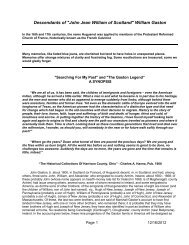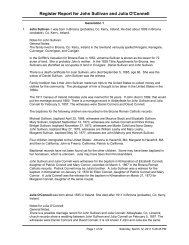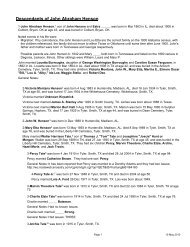Create successful ePaper yourself
Turn your PDF publications into a flip-book with our unique Google optimized e-Paper software.
In my experience, <strong>home</strong>opathic treatment is the most effective for dealing with the<br />
underlying issues and should be used in conjunction with physical therapy.<br />
2<br />
Dr. Diderik Finne<br />
The following series of exercises are designed first to stretch, then strengthen the iliopsoas.<br />
Some of the poses are demonstrated in animation at the following website:<br />
http://www.bandhayoga.<strong>com</strong>/keys_psoas.html.<br />
Begin the sequence with a gentle stretch, a modified Pavanamuktasana (Wind Removing<br />
Pose):<br />
1. Lying on your back with a small pillow or<br />
cushion under your head, bring your left<br />
leg up and clasp it at the knee. Keep your<br />
neck relaxed and scapulas anchored.<br />
2. Breathe in.<br />
3. While breathing out, slowly stretch your<br />
right leg out along the floor. It is more<br />
important to keep the pelvis stable than to<br />
totally straighten the leg.<br />
4. Breathe in.<br />
5. While breathing out, bring your right leg back<br />
to the start position.<br />
Repeat twice each side.<br />
This stretch ac<strong>com</strong>plishes the following:<br />
1. Gently lengthens the <strong>Psoas</strong> to its required length without danger of overstretching.<br />
2. Stabilizes the pelvis and helps to avoid low back pain.<br />
3. Limbers up the <strong>Psoas</strong> in preparation for strengthening exercises.<br />
If the iliopsoas is in acute spasm, you should do nothing more than this exercise<br />
until the pain begins to dissipate. When you are ready to proceed, be conservative<br />
and do not push yourself, but try to relax into the postures.<br />
1. Put your left foot on a stool, so you are in a modified forward<br />
stance. Interlace your fingers and raise your hands over your<br />
head, trying to keep the arms as close as possible to your ears.<br />
Hold for a count of 10.<br />
2. If you are able to do this position without difficulty, slowly bring<br />
your hands backwards to increase the stretch on your lower back.<br />
Hold for an additional count of 10.<br />
3. If you are able to hold this position, slowly move your hands<br />
laterally to the left, so you are bending both backwards and<br />
laterally at the waist. This stretch is specific for the iliopsoas.<br />
Hold for a count of 20, or as long as you can.<br />
4. Repeat on the opposite side.<br />
To strengthen the iliopsoas, isometric contraction is used to isolate and awaken the dormant<br />
muscle. This technique requires an understanding of the action of the various muscles. For<br />
example, the psoas acts to flex the hip, i.e. either to bend the trunk forward or draw the<br />
knee up. These are the motions emphasized in the following postures.







